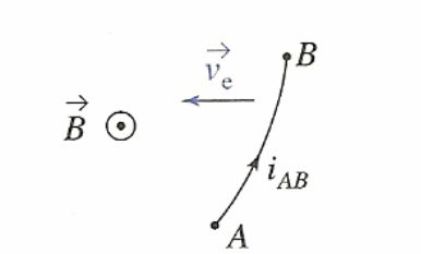Power of the induced electromotive force and the Laplace's force
Fondamental :
A charge carrier is put in a permanent magnetic field.
It moves with a velocity \(\vec v\) in relation to the conductor, but the conductor moves at velocity \(\vec v_e\) in the laboratory referential \((R_0)\).

In this referential, the charge carrier has a speed (\(\vec v +\vec v_e\)) and is subject to Lorentz's Force :
\(\vec f_{Lorentz}=q(\vec v + \vec v_e)\wedge \vec B\)
Yet its power is equal to zero :
\(\left[ {q(\vec v + {{\vec v}_e}) \wedge \vec B} \right].(\vec v + {\vec v_e}) = 0\)
This power can be separated in 4 terms, and two of them are equal to zero :
\(q(\vec v \wedge \vec B).\vec v + q(\vec v \wedge \vec B).{\vec v_e} + q({\vec v_e} \wedge \vec B).\vec v + q({\vec v_e} \wedge \vec B).{\vec v_e} = q(\vec v \wedge \vec B).{\vec v_e} + q({\vec v_e} \wedge \vec B).\vec v\)
In an elementary volume \(d\tau\), the number of charge carriers is \(nd\tau\).
The density of power of Lorentz's force is :
\(nd\tau \left[ {q(\vec v \wedge \vec B).{{\vec v}_e} + q({{\vec v}_e} \wedge \vec B).\vec v} \right] = 0\)
The term :
\(nd\tau \;q({\vec v_e} \wedge \vec B).\vec v\)
represents the density of power of the force applied to the charges because of the electromotive field \(\vec E_m=\vec v_e \wedge \vec B\).
This density is evaluated in the referential of the conductor.
By adding it on the whole volume of the conductor, the power of the induced electromotive force \(P_e\) is found :
\({P_e} = \iiint nd\tau \;q({\vec v_e} \wedge \vec B).\vec v =\iiint ({\vec v_e} \wedge \vec B).\vec j\;d\tau =\iiint ({\vec v_e} \wedge \vec B).d\vec \ell \;i = ei\)
Interpretation of the term \( nd\tau \;q(\vec v \wedge \vec B).{\vec v_e}\) :
\(nd\tau \;q(\vec v \wedge \vec B).{\vec v_e} = (\vec j\;d\tau \wedge \vec B).{\vec v_e}\)
This term appears to be the power of Laplace's force applied to elementary volume \(d\tau\).
Finally, after integration :
\({P_e} + {P_L} = ei + {P_L} = 0\)
The power of the induction electromotive force is compensated by that of the actions of the Laplace's force on the circuit.
Attention : Power of induced electromotive force and Laplace's force
\({P_e} + {P_L} = ei + {P_L} = 0\)
The power of the induction electromotive force is compensated by that of the actions of the Laplace force on the circuit.